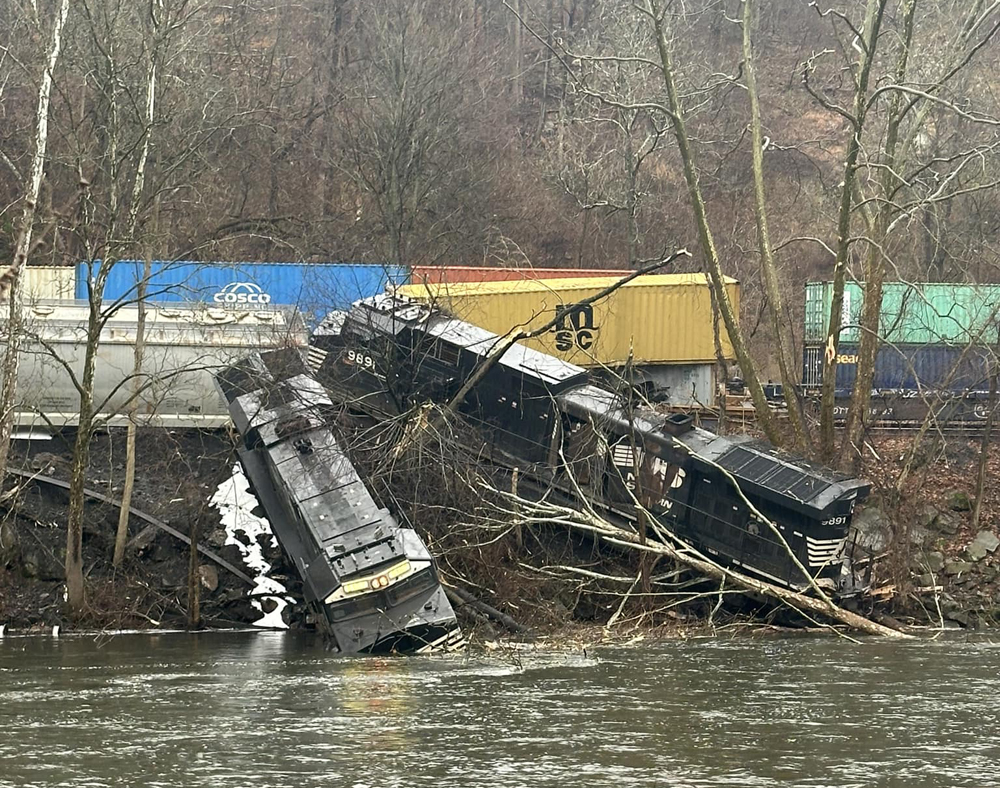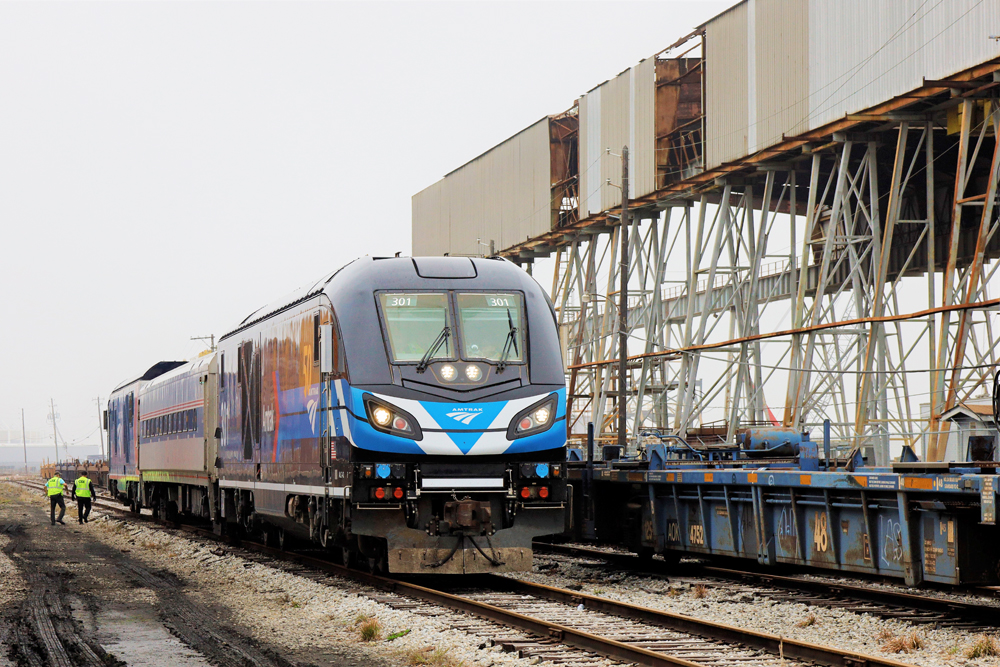
Ancora Holdings, the activist investor leading a proxy fight against Norfolk Southern, says it’s taking the high road and conducting a fact-based campaign to oust the railroad’s management. The reality is that Ancora is stuck on the misinformation highway with a safety white paper that makes several claims that can’t hold up to scrutiny.
Ancora’s white paper was released on March 7, five days after a collision and derailment involving three NS trains in Lower Saucon Township, Pa. An eastbound train struck the rear of a stationary train at 7:15 a.m., with derailed cars fouling the adjacent track. Less than a minute later a westbound train came along, struck the wreckage, and derailed, the National Transportation Safety Board said on March 6. No one was injured, but diesel fuel and plastic pellets were spilled into the Lehigh River.
The wreck, Ancora says, is more justification for the NS board to immediately dismiss CEO Alan Shaw. Ancora correctly concludes that the Lower Saucon incident was preventable. But its white paper contains several glaring errors.
First, the white paper gets off to a rocky start. It’s titled “Norfolk Southern Board Nominees State Serious and Urgent Concerns About Recent Unpublicized Norfolk Southern Locomotive Collisions.” The text of the white paper never mentions any unpublicized collisions.
Second, Ancora says it can’t understand how a collision could occur in territory protected by positive train control. “Congress has mandated that Positive Train Control (PTC) systems be put in place on mainlines in part to prevent two trains from colliding from the rear or head-on by automatically controlling the speed and braking of the moving trains. Given the role and importance of systems like PTC, the possibility for an incident like this to happen would require a failure of the system or direction to override the system by Norfolk Southern management. As such, the Lehigh Valley accident raises important questions about the functionality (or lack thereof) of the PTC system on this section of the line,” Ancora says.
This statement prompted eye rolls from railroaders who fully grasp how PTC works. PTC is not designed to prevent rear-end collisions when a train is operating at restricted speed. And in a March 6 briefing — the day before Ancora rushed out its white paper — the lead NTSB investigator said the second eastbound train was operating at a speed below the PTC threshold. In this case, it’s likely the second eastbound had a signal indication that allowed it to continue at restricted speed, a common practice across the industry.
The NTSB’s report ultimately will determine probable causes and contributing factors involved in the collision and derailment. Ancora has already reached a conclusion based on its faulty PTC analysis: “In our estimation, the events of March 2, 2024 suggest that the automatic controls, the judgments of operators or a systemic failure resulted in two trains being permitted to collide on the same track. In our experience, a conductor’s view from a locomotive is only approximately a half mile, and visibility may have been further limited by rain at the time of the accident, while a freight train traveling at normal speed of 45 mph takes approximately one mile to stop. In such cases, railroads must rely on other safety measures — including extremely low speed, careful estimation of distance and positioning using wayside signaling — to augment a PTC system that may not be functioning well or even at all. Seen in this light, we believe that the accident raises serious concerns about the culture of safety at Norfolk Southern.”
Third, Ancora wonders how “the initial collision was permitted to escalate into a three-train accident. Why did Norfolk Southern clear the westbound train to proceed past the two trains that had already collided on the adjoining eastbound tracks, and that had already resulted in wrecked cars on the westbound track?”
The NTSB answered that question on March 6. The westbound collided with the wreckage less than a minute after the initial collision and derailment, making it impossible to prevent.
Yet again Ancora jumps to a conclusion that’s not supported by the facts: “We believe this second collision raises important concerns with Norfolk Southern’s controls. … It would appear that either the information technology systems, which should have alerted operators to a problem on the line, either failed to do so, or the operators failed to appreciate that the westbound line was heavily impaired by the first collision.”
If Ancora were actually interested in running a fact-based proxy battle, it would have either removed the white paper from its MoveNSForward website or corrected the document. It’s done neither.

Finally, the news release accompanying Ancora’s white paper leads off with a highly misleading statement: “New Leadership Plans to Require Every Norfolk Southern Train Operating on a Mainline to Have a Two-Person Crew, Representing an Important Upgrade to the Company’s Current Policy.” This makes it sound like NS already has engineer-only operations, which of course is not the case.
Every Norfolk Southern train operating on a main line currently operates with a crew of at least two people. Labor-management agreements require operation with an engineer and conductor aboard the train. And the Federal Railroad Administration has proposed a rule that would mandate two-person crews. So how Ancora’s two-person crew requirement is an “important upgrade” is a real head-scratcher.
It’s fair game to challenge a railroad’s safety record and pose critical questions about a particular incident. But Ancora loses credibility when it makes points that are flat-out wrong, gets ahead of the facts, and rushes to judgment.
You can reach Bill Stephens at bybillstephens@gmail.com and follow him on LinkedIn and X @bybillstephens














Pity NS was too naive to have a robust defense plan against this type of “investment”.
Can NS (or Shaw) sue these people for libel? This is beyond ridiculous.
It just shows how Ancora and Wall St know nothing to very little about the nuts and bolts of the industry. Why would we trust them to run NS. There only want is to gut it for more money for themselves and their shareholders. Largely for themselves.
You say “Since they were cleared for slow progress below the speed PTC works it was the crews responsibility to be able to stop the Tran from hitting the first train.”
So why was a train crew cleared to follow so close to another train? Maintaining separation is paramount to safety. Two trains traveling in the same direction simply shouldn’t be cleared into same block. You might say this is standard practice, but should it be? If weather or sight distance was an issue, the the following train was traveling to fast. Another reason to force separation rather than rely on apparently unreliable factors to permit close following.
Thanks for pointing out the problem with PTC. I wondered why it would not have stoped the second train from hitting the stoped first train. Since they were cleared for slow progress below the speed PTC works it was the crews responsibility to be able to stop the Tran from hitting the first train.
Bill, excellent analysis. Your comments are right on the money.
David C. Lester
Editor-in- Chief
Railway Track and Structures
Thank you, David.
We who comment on these pages are charged to read the incident report before placing blame. I should think the same applies to those Ancora people.
Let us hope truth, facts and evidence are not ignored in deference to shameful motives.